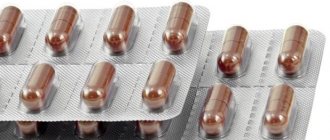Indications for use
What does Clopidogrel help with? The drug has the following indications for use:
- prevention of thrombotic and thromboembolic complications in atrial fibrillation, in the presence of at least one factor for the occurrence of vascular complications, when it is impossible to use indirect anticoagulants and there is a low probability of bleeding;
- prevention of thrombotic complications in patients with ischemic stroke, myocardial infarction or disturbance of the lumen of peripheral arteries. Tablets are used together with acetylsalicylic acid to prevent thrombotic events in acute coronary syndrome.
Relevance
Peripheral artery disease is considered a manifestation of systemic atherosclerosis and is associated with the development of adverse cardiovascular events and critical lower limb ischemia.
Results from previous studies suggest that patients receiving clopidogrel monotherapy have a lower risk of cardiovascular events compared with those receiving aspirin.
Purpose
The present study was to compare the antiplatelet drugs clopidogrel and ticagrelor in the treatment of this group of patients.
Instructions for use
Clopidogrel is taken orally, regardless of food intake. For adults and elderly patients, the drug is prescribed in a daily dose of 75 mg in 1 dose. Therapy must be started: after myocardial infarction - from 1 to 35 days; after an ischemic stroke - in the period from 7 days to 6 months. The dosage regimen is determined by the indications:
Acute coronary syndrome without ST segment elevation ( unstable angina or non-Q wave myocardial infarction ): therapy begins with a single loading dose of 300 mg, then 75 mg per day is used simultaneously with acetylsalicylic acid (75-325 mg per day).
The recommended dose of acetylsalicylic acid is up to 100 mg per day, since higher doses increase the risk of bleeding. The maximum beneficial effect develops after 3 months. Duration of treatment course – up to 1 year;
Acute coronary syndrome with ST segment elevation ( acute myocardial infarction with ST segment elevation ): 75 mg per day with an initial loading dose (single dose) simultaneously with acetylsalicylic acid and thrombolytics (or without them). In patients with a genetically determined decrease in the activity of the CYP2C19 isoenzyme, the effect of Clopidogrel may be reduced. For such patients, the optimal dosage regimen has not been established.
By
Contraindications
- hypersensitivity to the components of the drug
- acute bleeding (eg, from a peptic ulcer or intracranial hemorrhage)
Use during pregnancy and lactation
Adequate and strictly controlled clinical studies of the safety of the drug during pregnancy have not been conducted. Therefore, clopidogrel can be prescribed during pregnancy only if absolutely necessary. If it is necessary to prescribe during lactation, the issue of stopping breastfeeding should be decided. There is no data on the excretion of clopidogrel and its metabolites in human breast milk. In experimental studies using clopidogrel at a dose of 300-500 mg/kg body weight per day, no teratogenic effect of the drug and no negative effect on animal fertility and fetal development were revealed. It has been established that clopidogrel and its metabolites are excreted in breast milk.
Additional restrictions
Clopidogrel is prescribed with caution if there is an increased risk of bleeding due to injury, surgery, or disorders of the hemostatic system. For planned surgical interventions (if the antiplatelet effect is undesirable), the course of treatment should be stopped 7 days before surgery. Clopidogrel is prescribed with caution to patients with severe liver dysfunction, in which hemorrhagic diathesis may occur, since experience with the drug in such patients is limited. Patients should be warned that since stopping bleeding that occurs during the use of clopidogrel takes longer, they should report to the doctor any case of unusual bleeding. Patients should also inform the doctor and dentist about taking the drug if they are undergoing surgery or if the doctor prescribes a new drug for the patient.
Control of laboratory parameters
If symptoms of excessive bleeding appear (bleeding gums, menorrhagia, hematuria), a study of the hemostasis system (bleeding time, platelet count, platelet functional activity tests) is indicated. Regular monitoring of laboratory parameters of liver function is recommended.
Studies on laboratory animals did not reveal carcinogenic or genotoxic effects.
Impact on the ability to drive vehicles and operate machinery
Not installed.
Overdose
When taken orally at a single dose of 600 mg (an amount equivalent to 8 standard 75 mg tablets) by healthy volunteers, no side effects were noted. Bleeding time was extended by 1.7 times, which corresponds to the value recorded after taking a therapeutic dose (75 mg/day). Treatment: platelet transfusion. There is no specific antidote.
Drug interactions
Since the mechanism of action of clopidogrel and acetylsalicylic acid is different, and the difference in the price of the drugs is very large, it is tempting for clinicians to use their combination. When taken simultaneously (75 mg + 75 mg), a potentiating effect on platelet aggregation is noted. However, the safety/efficacy ratio for long-term simultaneous use of acetylsalicylic acid and clopidogrel has not yet been definitively established. There is evidence of the need for refined differential diagnosis for effective joint use
When used concomitantly with heparin, according to a clinical trial conducted in healthy volunteers, clopidogrel does not change either the total requirement for heparin or the effect of heparin on blood clotting. Simultaneous long-term use of heparin did not change the inhibitory effect of clopidogrel on platelet aggregation. However, the safety of this combination has not yet been established and the simultaneous use of these drugs requires caution.
When used concomitantly with recombinant tissue plasminogen activator (rt-PA), the safety of combined use of clopidogrel, rt-PA and heparin was studied in patients with a recent myocardial infarction. The incidence of clinically significant bleeding was similar to that observed with concomitant use of rt-PA and heparin. The safety of concomitant use of clopidodogrel with other thrombolytics has not yet been established, and the simultaneous use of these drugs requires caution.
The safety of combined use of clopidogrel and warfarin has not yet been established. Concomitant use of clopidogrel with warfarin is not recommended as this combination may increase bleeding. Prescribing NSAIDs with clopidogrel requires caution.
No clinically significant pharmacodynamic interaction was observed when clopidogrel was used in combination with atenolol and nifedipine. The pharmacodynamic activity of clopidogrel remained virtually unchanged when used simultaneously with phenobarbital, cimetidine or estrogens. The pharmacokinetic properties of digoxin or theophylline do not change when used together with clopidogrel.
Antacids did not change the absorption rates of clopidogrel. Prescribing glycoprotein IIb/IIIa inhibitors with clopidogrel requires caution.
Side effects
The use of Clopidogrel may cause the following undesirable reactions:
- Blood coagulation system: hemorrhagic stroke, bleeding in the gastrointestinal tract;
- Digestive system: formation of ulcers in the duodenum and stomach, gastritis, pain in the abdomen, constipation, dyspeptic symptoms, diarrhea.
- Hematopoietic system: thrombocytopenia and neutropenia.
- Dermatological manifestations: rash on the skin.
Pharmacological effects
The instructions for use of Clopidogrel indicate that the drug is a prominent representative of the subgroup of antiplatelet agents. It is inherent to suppress the aggregation of red blood platelets - platelets, and also significantly reduce the binding of adenosine diphosphate to receptor endings on the walls of platelets. In addition, the adhesion of blood components is prevented due to the elimination of the induction of the GPIIb/IIIa complex.
Main pharmacological properties:
- prevention of platelet aggregation;
- blocking aggregation of blood platelets caused by other agonists;
- stopping the stimulation of platelets released due to adenosine diphosphate;
- ensuring irreversible transformation of adenosine diphosphate receptors on platelet walls;
- absorption from intestinal loops.
By
Drug interactions
When taken together with drugs from the group of non-steroidal anti-inflammatory drugs, the likelihood of gastrointestinal bleeding increases.
When used together with acetylsalicylic acid, the antiplatelet effect is likely to be enhanced.
Since Clopidogrel inhibits the CYP2C9 isoenzyme, when used together with drugs that transform with the participation of CYP2C9 (for example, with tolbutamine and phenytoin), an increase in their concentrations in the blood cannot be ruled out.
Clopidogrel: contraindications and interactions with other drugs
Before taking clopidogrel, tell your doctor and pharmacist if you are allergic to clopidogrel, prasugrel, ticlopidine, any other drugs, or any ingredient in clopidogrel. Ask your pharmacist for a list of the drug's ingredients.
Tell your doctor and pharmacist what other prescribed and nonprescription drugs, vitamins, dietary supplements, and herbal products you are taking or plan to take. Be sure to include any of the following medications: anticoagulants such as warfarin; aspirin and other nonsteroidal anti-inflammatory drugs (NSAIDs), such as ibuprofen and naproxen; cilostazol; esomeprazole; etravirine; omeprazole; selective serotonin reuptake inhibitors such as citalopram, escitalopram, fluoxetine, fluvoxamine, paroxetine and sertraline; selective serotonin norepinephrine reuptake inhibitors, such as duloxetine, sibutramine and venlafaxine. Your doctor may need to change the doses of your medications or monitor you closely for side effects.
Tell your doctor if you have stomach or small intestinal ulcers, bleeding in the brain, or if you have or have ever had liver or kidney disease.
Tell your doctor if you are pregnant, plan to become pregnant, or are breastfeeding. If you become pregnant while taking this drug, call your doctor. If you must have surgery, including dental surgery, tell the doctor or dentist that you are taking this medicine.
Analogues of the drug Clopidogrel
Analogues are determined by structure:
- Zilt.
- Listab 75.
- Deplatt 75.
- Plavix.
- Plagril.
- Lirt.
- Plogrel.
- Trombex.
- Targetek.
- Clopidogrel hydrosulfate.
- Cardutol.
- Clopidogrel bisulfate.
- Trocken.
- Clopylet.
- Dethromb.
- Coplavix (in combination with aspirin).
- Cardogrel.
- Aegitromb.
- Thromborel.
- Clopidogrel Teva, Richter, SZ.
- Clopigrant.
- Lopirel.
- Clopidex.
- Aggregate.










